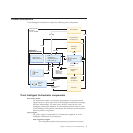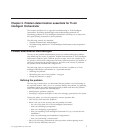
v Each asset is represented by a data center object. When you make a
change to an asset with Tivoli Intelligent Orchestrator, the data center
object is updated in the data center model. If a change is made outside
of Tivoli Intelligent Orchestrator, the external change can be identified by
comparing it with the data center object in the data center model.
v For some data center assets, the data center model stores data about the
asset and data about deploying or provisioning the asset separately to
provide a range of implementation options. For example, when a
software package is added to the Tivoli Intelligent Orchestrator software
catalog, you define the software package as a installable file. You can
then create software definitions that describe different configuration
requirements and configuration options for installing the same software
package.
v You can create templates that define standard configurations. For
example, you can create a server template that includes the routing,
software, and storage configuration for a particular application tier.
When a server is added to the application tier, the defined configuration
is automatically applied.
v You can define application topologies that describe requirements for an
application. You can then deploy an application based on the defined
application requirements.
Orchestrating
provisioning
You can configure Tivoli Intelligent Orchestrator to dynamically allocate
resources to applications based on demand or priority. Applications can
share pools of available resources to optimize utilization and eliminate idle
resources or excess allocation of resources.
Product comparison
Tivoli Intelligent Orchestrator includes Tivoli Provisioning Manager, a standalone
product that can be purchased separately, based on your data center needs. Tivoli
Provisioning Manager provides core automated deployment capability, while Tivoli
Intelligent Orchestrator adds policy-based decision-making capabilities.
Tivoli Intelligent Orchestrator uses historical and current demand and performance
data, as well as defined business policies to determine where and when to allocate
resources. When a deployment decision is made, Tivoli Intelligent Orchestrator
runs workflows to automatically make the required configuration and allocation
changes. You can specify the degree of automated provisioning that you require at
the global, application, and tier level.
The following table summarizes the complementary roles of the two products:
Tivoli Intelligent Orchestrator Tivoli Provisioning Manager
Orchestrates automation Coordinates provisioning
Determines why, when, and where: Senses
why an action is necessary, anticipates when
to start provisioning, and prioritizes where
to put resources.
Coordinates what and how: Determines
what data center assets to provision and
provisions them based on your defined
business processes.
2 Tivoli Intelligent Orchestrator Problem Determination and Troubleshooting Guide


















